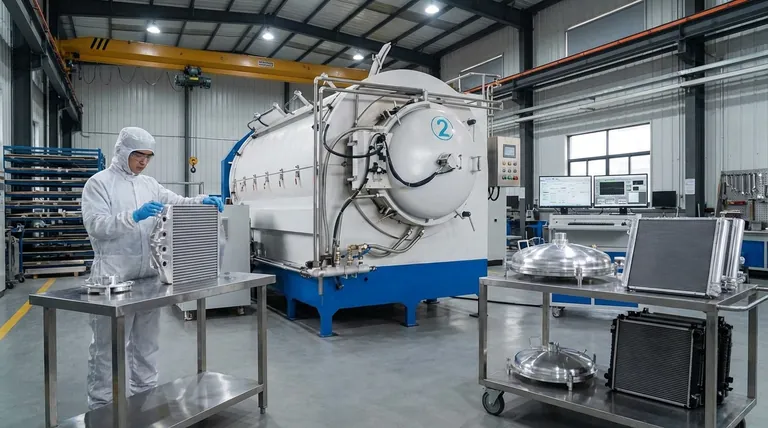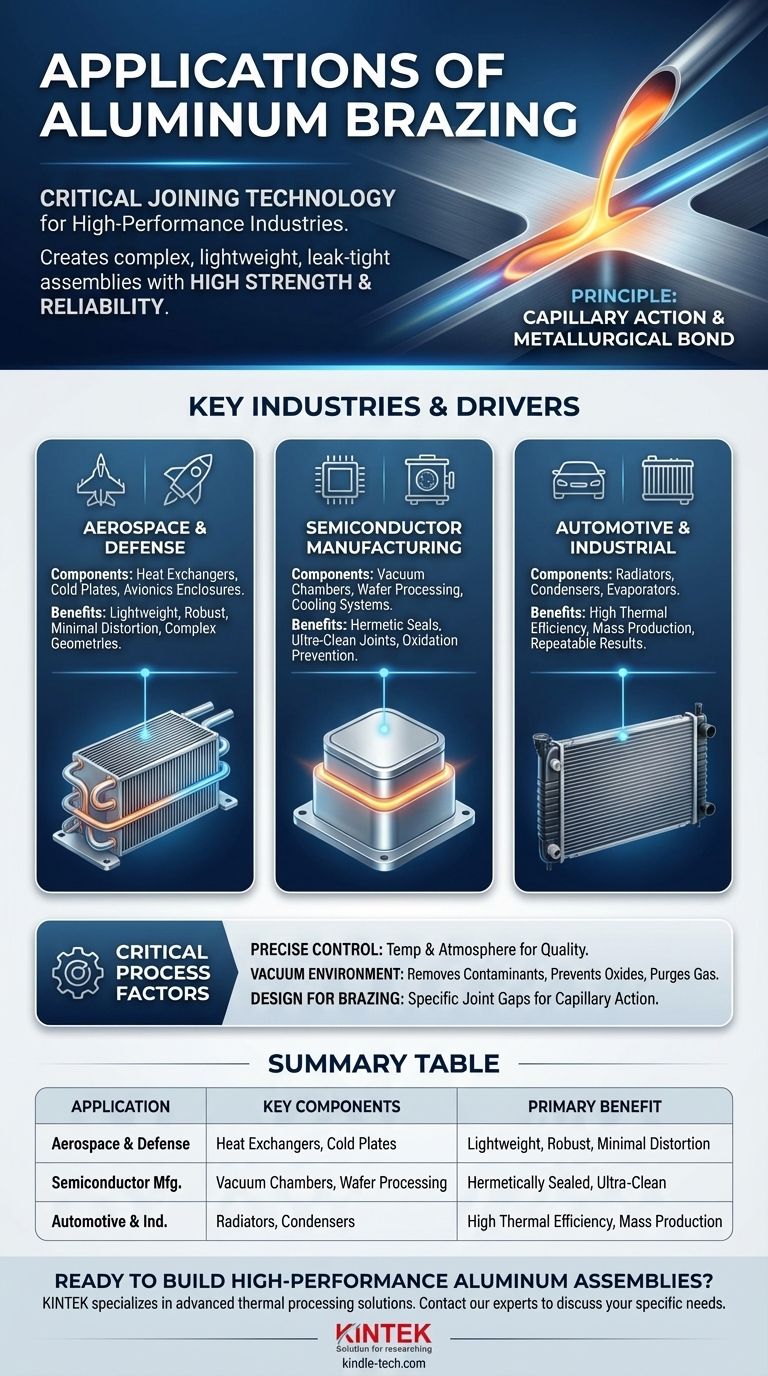In short, aluminum brazing is a critical joining technology used in high-performance industries like aerospace, semiconductor manufacturing, and automotive. It is the preferred method for creating complex, lightweight, and leak-tight assemblies that require high strength and reliability, such as advanced heat exchangers, vacuum components, and avionic chassis.
The true value of aluminum brazing is not just in joining aluminum parts, but in its ability to create strong, clean, and hermetically sealed bonds across large, complex assemblies with minimal distortion—a capability that traditional welding often cannot match.

Why Aluminum Brazing is a Critical Process
To understand its applications, you must first understand the fundamental principles that make aluminum brazing so effective for demanding engineering challenges.
The Principle of the Process
Aluminum brazing joins base metal components using a filler metal alloy with a lower melting point. This filler metal, typically heated to between 580-620°C (1076-1148°F), becomes liquid long before the parent aluminum parts do.
This molten filler is then drawn by capillary action into the narrow gaps between the parts being assembled.
Creating a Strong Metallurgical Bond
Upon cooling, the filler metal solidifies, creating a continuous, strong metallurgical bond between the components. This is not a simple adhesive joint; it is a true fusion of materials that results in a solid, sealed, and durable assembly.
Key Applications and Their Technical Drivers
The unique benefits of this process make it the go-to solution for specific industrial applications where performance and reliability are non-negotiable.
Aerospace and Defense
In aerospace, every gram matters. Aluminum brazing is used to manufacture lightweight yet robust components like heat exchangers, cold plates, and avionics enclosures.
The process allows for the creation of complex geometries with thin walls and numerous joints, all joined in a single, controlled cycle. The uniform heating and cooling inherent to furnace brazing minimizes part distortion, which is critical for maintaining tight tolerances in aerospace hardware.
Semiconductor Manufacturing
The semiconductor industry demands absolute cleanliness and hermetic sealing. Vacuum brazing is essential for creating components for vacuum chambers, wafer processing equipment, and cooling systems.
The vacuum environment prevents oxidation, resulting in an exceptionally clean joint that requires no post-process finishing. This process is ideal for creating the hermetically sealed bond necessary to maintain the ultra-high vacuum environments required for semiconductor fabrication.
Automotive and Industrial
In the automotive sector, aluminum brazing is the standard for producing radiators, condensers, and evaporators. The ability to join thousands of thin aluminum fins to tubes simultaneously makes it highly efficient for mass production.
This process ensures highly repeatable results and creates a continuous bond path, maximizing thermal transfer efficiency in heat exchangers.
Understanding the Trade-offs and Requirements
While powerful, aluminum brazing is a specialized process that demands careful control and planning to achieve a successful outcome.
The Need for Precise Control
The quality and lifespan of a brazed product are directly tied to the process conditions. Temperature, heating/cooling rates, and furnace atmosphere must be meticulously controlled to ensure the filler metal flows properly without damaging the base components.
The Advantage of Vacuum Environments
For oxide-sensitive materials like aluminum, vacuum furnace brazing is often the superior method. The vacuum actively removes air and other contaminants, preventing the formation of oxides that would otherwise inhibit the flow of filler metal and compromise the joint's integrity.
This also helps purge entrapped gas from long or complex joint paths, ensuring a complete, void-free bond.
Designing for Brazing
You cannot simply substitute brazing for another joining method. Parts must be designed specifically for the process, with joint gaps engineered to precise tolerances (typically a few thousandths of an inch) to promote effective capillary action.
Making the Right Choice for Your Application
Use aluminum brazing when the design requirements align with the core strengths of the process.
- If your primary focus is high-performance and reliability: Brazing is a premier choice for creating the lightweight, strong, and hermetically sealed joints required in aerospace and semiconductor applications.
- If your primary focus is joining complex assemblies: Brazing offers unmatched efficiency for joining hundreds or thousands of joints simultaneously, as seen in the production of automotive heat exchangers.
- If your primary focus is part integrity and cleanliness: The controlled, uniform heating of furnace brazing minimizes distortion, and a vacuum environment produces pristine joints ideal for sensitive equipment.
Ultimately, aluminum brazing empowers engineers to build complex, high-performance components that would be impractical or impossible to create with other methods.
Summary Table:
| Application | Key Components | Primary Benefit |
|---|---|---|
| Aerospace & Defense | Heat exchangers, cold plates, avionics enclosures | Lightweight, robust, minimal distortion |
| Semiconductor Manufacturing | Vacuum chambers, wafer processing equipment | Hermetically sealed, ultra-clean joints |
| Automotive & Industrial | Radiators, condensers, evaporators | High thermal efficiency, mass production capability |
Ready to build high-performance aluminum assemblies? KINTEK specializes in advanced thermal processing solutions for the most demanding laboratory and industrial applications. Our expertise in aluminum brazing can help you achieve strong, reliable, and leak-tight joints for your aerospace, semiconductor, or automotive projects. Contact our experts today to discuss how we can support your specific needs with precision lab equipment and consumables.
Visual Guide

Related Products
- Vacuum Heat Treat Sintering Brazing Furnace
- Vacuum Heat Treat Furnace and Levitation Induction Melting Furnace
- Vacuum Heat Treat Furnace with Ceramic Fiber Liner
- 2200 ℃ Tungsten Vacuum Heat Treat and Sintering Furnace
- Molybdenum Vacuum Heat Treat Furnace
People Also Ask
- Can dissimilar metals be brazed or braze welded? A Guide to Strong, Reliable Joints
- What is the process of a vacuum furnace? Achieve Purity and Precision in High-Temp Processing
- What is brazing in heat treatment? Achieve Superior Joint Quality and Efficiency
- Where are vacuum furnaces used? Essential for High-Purity Heat Treatment in Critical Industries
- What is a vacuum furnace used for? Unlock Purity in High-Temperature Processing



















